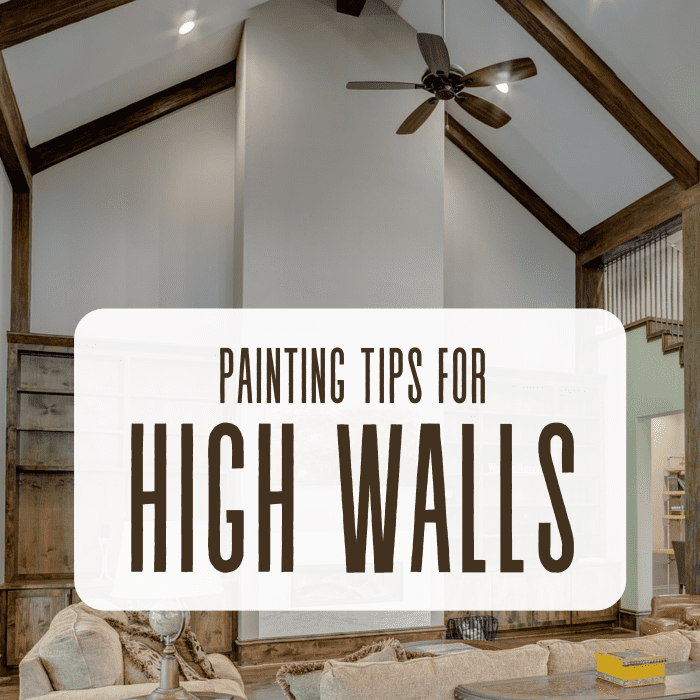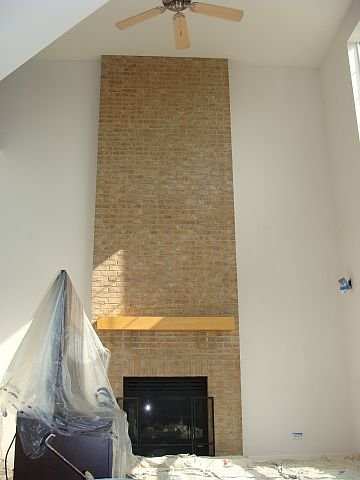Best Color to Paint Concrete Block Walls
Matt is a professional painter and freelance writer, sharing his knowledge, house-painting tips, and product reviews.

Get advice from a professional painter on how to successfully paint high walls in your home.
Image by Solomon Rodgers from Pixabay
Tips for Painting High Walls
Painting high walls inside a home is a project some homeowners avoid doing themselves, but it's actually quite easy if you use the right tools and equipment.
- Choose the Right Equipment
- Paint the Ceilings Before the Walls
- Select the Best Paint Finish
- Repair Drywall and Tape Baseboard
- Cut-in the Ceiling Line
- Roll the Paint Correctly
- Consider an Extension Ladder Alternative
1. Choose the Right Equipment
An aluminum, 24-foot extension ladder, is suitable for painting most two-story walls in a home. Aluminum is much lighter than fiberglass, making it safer and easier to maneuver inside the house. For most high walls in a bedroom, a 16-foot extension ladder is ideal.
2. Paint the Ceiling Before the Walls
Skip this part if you aren't painting the ceiling. But if you are, always paint the ceiling before you paint the walls. This way it won't matter if you drip a little paint on the walls in the process. If you were to paint the walls first, and the ceiling last, you would have to protect the walls with plastic and also brush in the ceiling paint upside down to the wall edges.
3. Select the Best Paint Finish
There isn't necessarily a right or wrong finish for big walls inside a home, but I don't recommend overly shiny paints. Personally, I would avoid semi-gloss or gloss. I have painted high walls in many homes and either flat (non-shiny) or eggshell (shiny) looks fine. Some people like shiny walls and some people don't, but do consider the current condition of the drywall as one of the determining factors. If you can see the joints in the drywall, nail pops, or uneven areas, shiny paint will highlight those problems even more, especially if the room is well lit.
Choose a flat paint to dull the surface and draw less attention to imperfections on a poor drywall job. The only downside to flat paint is that it doesn't always clean well because it isn't very smooth. The downside to eggshell is that sometimes it shows lap marks from the paint roller, after the paint is dry, but that can be prevented by using a premium interior paint and rolling the paint correctly.
4. Repair Drywall and Tape Baseboard
Fill nail holes and make any drywall repairs before painting. I like to sand the walls before I paint, using a metal sanding head attached to a painting pole. Sanding the walls files down bumps and removes roller hairs in the existing paint finish. It makes the walls nice and smooth. Tape off the top of the baseboard with blue tape and remove outlet covers.

If you're painting the ceiling, too, then it's best to do that before you start on the walls.
5. Cut-in the Ceiling Line
Before you roll any paint onto the walls, complete all of the brush work first, using an extension ladder. This is the most time consuming part, because of the ladder work involved, but after the brush work is completed, you can put the ladder away, because the paint rolling is done from the ground using a pole.
It will probably take two coats with the brush, unless you're painting a color that's similar to the existing paint. Two coats always looks best, though. If you don't have a steady hand with the paint brush, you can resort to using blue tape, but it will take a lot longer to insert the tape into the corners, and tape doesn't always leave a straight line, either.
Read More From Dengarden
Step-by-Step Process
- To keep the floor protected from dripping paint, place drop cloths underneath the ladder. DO NOT set up the ladder with the feet directly on top of a drop cloth, or the ladder could slide across the floor when you're on it. Always keep the ladder feet on the bare floor itself.
- Pour a little paint into a clean empty gallon can.
- Snap a bucket hook onto the handle of the can and use it to hook the can to the top of the ladder after you climb up. The can takes up less space than a big bucket, and you can leave it attached to the ladder so you won't have both hands full while painting with the brush.
- Set up the ladder at one side of the room and work towards the other side.
- Use a 3-inch paint brush to cut-in the top of the high walls. A wider 3-inch brush holds more paint and will make the job go a little faster. I like to leave a 3" to 4" strip of paint at the wall top, when cutting-in, so it's easier to reach with the paint roller.
6. Roll the Paint Correctly
Now comes the fun part: rolling the paint onto the walls. The good news is that you won't need the ladder anymore. Head down to the paint store and buy a large painting pole. In some cases, a 4- to 8-foot pole will be long enough to reach the top of high walls if you stand on a stepladder. You can also buy a longer 8- to 12-foot painting pole, but in many cases the 4 to 8 pole is long enough and easier to work with.
Prep and Supplies
- Make sure all of the floors are protected with drop cloths and the walls are repaired and sanded.
- For eggshell (shiny) paint, use a 1/2" nap paint roller, which produces smaller stipple marks on the wall. A thicker roller, such as 3/4" nap, holds more paint, but the roller stipple at the bottom of the walls will be noticeably heavy at eye level if you're using a shiny paint finish.
- For flat (non-shiny) paint, a 3/4" nap roller is fine.
How to Apply the Paint
When rolling paint onto high walls in a foyer, or any other room inside a home, start at the top and work your way down, but only work in sections; don't skip around.
Start at one side of the wall and work towards the other side for an even finish. If you're painting two coats on the walls, the first coat doesn't have to be rolled in a perfect manner, as far as direction goes, but the second coat must be rolled evenly, in one direction, to avoid seeing roller marks after it dries.
For eggshell, or satin paint, always roll the paint evenly from the top all the way down to the bottom. Avoid rolling half the wall first and the second half last. If you paint high walls that way, you will see roller marks where the two sections overlap in the middle. It won't be as noticeable with flat paint, but it will stand out a lot with eggshell paint. Always roll from top to bottom and don't stop the roller in the middle of the wall.
7. Consider an Extension Ladder Alternative
Scared of heights? There is one solution, but it takes more time and doesn't always produce the best results. You can use a brush extender to cut-in high walls from the ground. A brush extender is a small metal adapter that screws onto the end of a painting pole. You insert the paint brush handle into the end of it.
If you don't have any experience with a brush extender, it does take some practice, especially if you're already bad at cutting-in straight lines at ceilings. A brush extender is really useful for cutting-in tricky walls in places where it's almost impossible to use an extension ladder. The downside is that if you mess it up and get paint on the ceiling, you will have to fix it or live with it. Although it takes some physical effort, using an extension ladder really is the best way to get the job done right.
This content is accurate and true to the best of the author's knowledge and is not meant to substitute for formal and individualized advice from a qualified professional.
© 2012 Matt G.
fyfx on January 21, 2020:
Thank You.
Best Color to Paint Concrete Block Walls
Source: https://dengarden.com/home-improvement/How-to-Paint-High-Walls
0 Response to "Best Color to Paint Concrete Block Walls"
Post a Comment